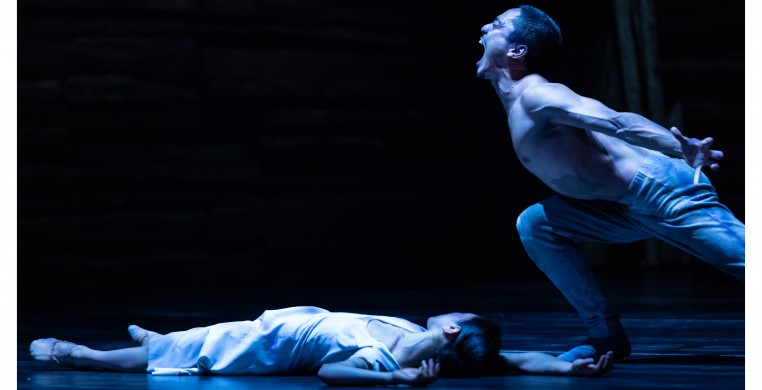Like Prometheus of Greek lore, interdisciplinary choreographer Akram Kahn once again brings the fire to Chicago with “Creature,” a dystopian ballet that made its international premiere Thursday night at the Harris Theatre for Music and Dance. Kahn, a natural collaborator, once again teams up with the English National Ballet, whose previous collaboration, a reimagined “Giselle,” was met with critical acclaim when it performed here in 2019.
“Creature” features original music and sound design by Vincenzo Lamagna, ably performed by the Chicago Philharmonic, conducted by Gavin Sutherland. Resembling the soundtrack of a blockbuster movie, the music makes every movement appear grandiose, every leap gaining momentum from billowing, sweeping violin arpeggios juxtaposed with dissonant, digital soundscapes. The final aural addition is that of the protagonist, Creature’s disembodied inner voice, recorded by Andy Serkis, which torments him from inside his own head, accompanied by wince-inducing, nails on a chalkboard.
The environment in “Creature” comes from the mind of Academy Award-winning production designer Tim Yip, whose sparse set reflects what life might look like in a barely habitable wasteland. Set on an isolated Arctic outpost, the aesthetic resembles that of the Soviet labor camp described in Aleksandr Solzhenitsyn’s chilling masterpiece, “The Gulag Archipelago,” appearing as a rickety workhouse, constructed from rotting planks, stacked two-stories high, that undulate, shake, and break apart without a moment’s notice. It’s one of those sets that has you looking closely in every dark corner, trying to anticipate the next surprise.
“Creature” begins with a low rumble, barely audible at first, that becomes the roar of a rocket engine, as a ghostly figure emerges from complete darkness, kneeling before an urn of glowing light, plunging both hands into it, cupping its contents, bathing in the luminescent glow while the looping, distorted voice of President Nixon sends out a message to pioneering spacemen, “Because of what you have done, the heavens have become a part of man’s world.”
Creature, played by Jeffrey Cirio, is a human lab rat, an experiment scientifically altered to withstand inhuman temperatures in a hostile environment. Bare-chested and with toned muscle, Creature and the other workers in the colony toil away, pulling long cables, spinning immense cogs and hauling enormous machinery.
This is all done under the watchful eye of the Captain (Henry Dowden), a goose-stepping dandy dressed in an aviator-style military jacket and brandishing an opaque, cartoonish space helmet. Creature is not like the other workers, due to scientific engineering and sporadically suffers from a fractured psyche that causes him to quickly switch from one persona to the next as though his mind were flipping impatiently through television channels—one moment he’s a clawing, snarling beast, the next a rifle-toting infantryman, the next a frightened and cowering child…
The only people who can calm him are his friend, Andres (Victor Prigent), and his handler, Marie, played by Erina Takahashi, whose kindness towards him causes Creature to fall in love with her. Left alone, the two perform a touching duet that has them frolicking playfully, tickling each other sheepishly, their faces getting close enough to almost kiss under the dim light of a single, rusty lamp.
The love that Creature feels for Marie is reminiscent of other monster/maiden love stories, like the original “King Kong”. Their love is shunned by society and it’s them against the world—and odds like that are seldom overcome.
An additional factor that drives them apart comes in the form of Major, played by James Streeter. Having set his lascivious sights, and hands, on Marie, he causes Creature to lose control, nearly taking the Major’s head off, and earning himself banishment to the frozen wasteland, but saved at near-death by Andres.
Although Creature is powerful, there is nothing that he can do to prevent the loss of his love and the destruction of his prison and himself. He is just another cog in the machine. A powerful one, but a cog, nonetheless.
The bad guys don’t get punished. The good guy doesn’t win or get the girl. Like certain environmental and social problems that people face today, there are solutions and remedies that can be done right now, but not if things get to a tipping point, whose unstoppable momentum abolishes any hope of healing.
As a terrible storm approaches, the Major and his minions flee for their lives, leaving Creature and Marie alone as the structure quickly crumbles around them. Creature, at last free from his tormentors, becomes divinely human, leaping, jumping, twirling in the air, from one side of the room to the other. He is graceful, angelic, no longer hampered by the voices threatening to drive him insane. But it is too late. He screams and rages, but is powerless to affect change, as the weight of the entire world collapses around him, devouring him.
The work serves as a dire warning of a possible, albeit avoidable, future for humanity. Will we manage to avoid disaster? I don’t know, but I do know this: We’ve been warned.
In 1975, French philosopher Michel Foucault wrote the book “Discipline and Punish: The Birth of the Prison,” and describes how social psychology can be transformed, and manipulated, through panoptic surveillance and examination. In 1836, Georg Büchner wrote Woyzeck,” the story of a destitute soldier recruited to serve as a research subject in an experiment, marking the first time that a human is characterized as a “research subject”. Earlier in the 19th century, Mary Shelley wrote “Frankenstein; or, The Modern Prometheus,” where a scientist creates a sapient creature who learns to hate humanity due to its abhorrent treatment of him based solely on how he looks. In February of 2022, I invite these authors to join us in their combined efforts manifested on the stage—Foucault, Büchner, Shelley… meet Creature!


